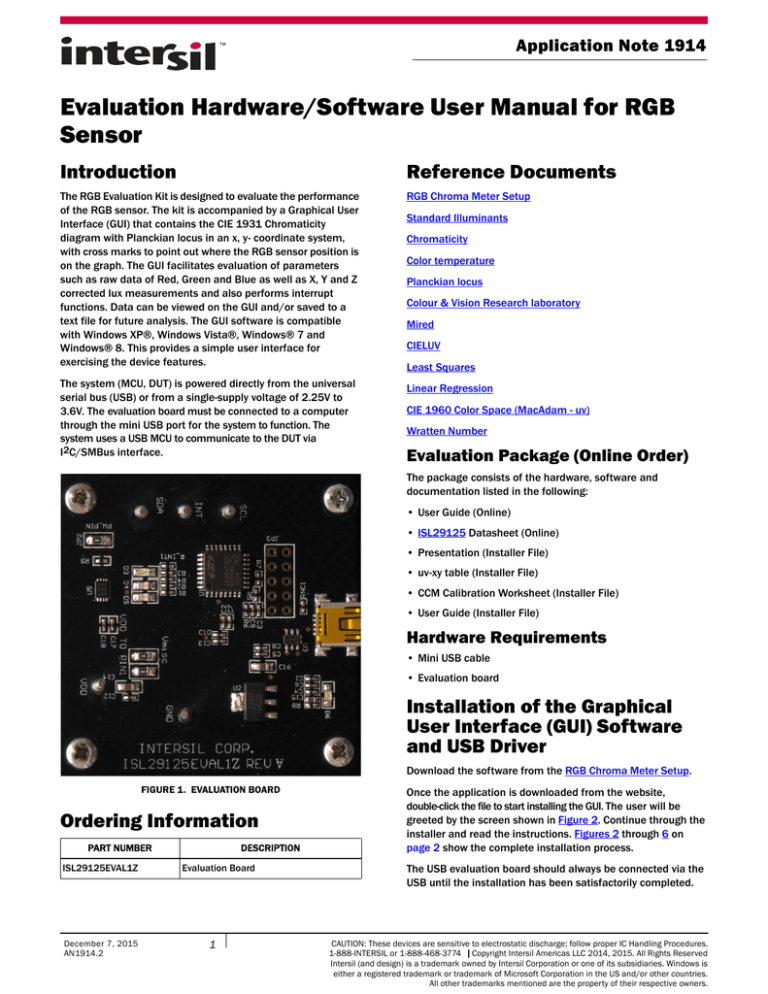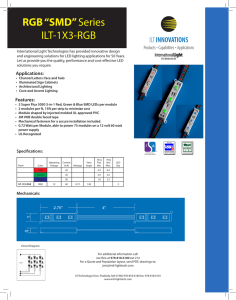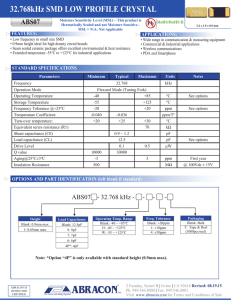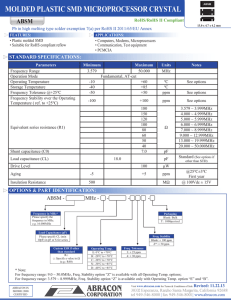
Application Note 1914
Evaluation Hardware/Software User Manual for RGB
Sensor
Introduction
Reference Documents
The RGB Evaluation Kit is designed to evaluate the performance
of the RGB sensor. The kit is accompanied by a Graphical User
Interface (GUI) that contains the CIE 1931 Chromaticity
diagram with Planckian locus in an x, y- coordinate system,
with cross marks to point out where the RGB sensor position is
on the graph. The GUI facilitates evaluation of parameters
such as raw data of Red, Green and Blue as well as X, Y and Z
corrected lux measurements and also performs interrupt
functions. Data can be viewed on the GUI and/or saved to a
text file for future analysis. The GUI software is compatible
with Windows XP®, Windows Vista®, Windows® 7 and
Windows® 8. This provides a simple user interface for
exercising the device features.
RGB Chroma Meter Setup
The system (MCU, DUT) is powered directly from the universal
serial bus (USB) or from a single-supply voltage of 2.25V to
3.6V. The evaluation board must be connected to a computer
through the mini USB port for the system to function. The
system uses a USB MCU to communicate to the DUT via
I2C/SMBus interface.
Linear Regression
Standard Illuminants
Chromaticity
Color temperature
Planckian locus
Colour & Vision Research laboratory
Mired
CIELUV
Least Squares
CIE 1960 Color Space (MacAdam - uv)
Wratten Number
Evaluation Package (Online Order)
The package consists of the hardware, software and
documentation listed in the following:
• User Guide (Online)
• ISL29125 Datasheet (Online)
• Presentation (Installer File)
• uv-xy table (Installer File)
• CCM Calibration Worksheet (Installer File)
• User Guide (Installer File)
Hardware Requirements
• Mini USB cable
• Evaluation board
Installation of the Graphical
User Interface (GUI) Software
and USB Driver
Download the software from the RGB Chroma Meter Setup.
FIGURE 1. EVALUATION BOARD
Ordering Information
PART NUMBER
ISL29125EVAL1Z
December 7, 2015
AN1914.2
DESCRIPTION
Evaluation Board
1
Once the application is downloaded from the website,
double-click the file to start installing the GUI. The user will be
greeted by the screen shown in Figure 2. Continue through the
installer and read the instructions. Figures 2 through 6 on
page 2 show the complete installation process.
The USB evaluation board should always be connected via the
USB until the installation has been satisfactorily completed.
CAUTION: These devices are sensitive to electrostatic discharge; follow proper IC Handling Procedures.
1-888-INTERSIL or 1-888-468-3774 | Copyright Intersil Americas LLC 2014, 2015. All Rights Reserved
Intersil (and design) is a trademark owned by Intersil Corporation or one of its subsidiaries. Windows is
either a registered trademark or trademark of Microsoft Corporation in the US and/or other countries.
All other trademarks mentioned are the property of their respective owners.
Application Note 1914
The installation program places the user interface software in
the directory indicated in Figure 5.
FIGURE 2. INSTALLATION WELCOME SCREEN
FIGURE 5. INSTALLATION DESTINATION LOCATION SCREEN
FIGURE 3. INSTALLATION FOLDER LOCATION SCREEN
FIGURE 6. INSTALLATION COMPLETE SCREEN
FIGURE 4. INSTALLATION LICENSE AGREEMENT SCREEN
Submit Document Feedback
2
December 7, 2015
AN1914.2
Application Note 1914
Running Program for the RGB GUI
A) USB Communication (Hardware) - Gather the required
materials and connect the PC to the ISL29125 by mini USB
cable as shown in Figure 7.
C) Once “ChromaMeter” is clicked, the window displayed in
Figure 9 should open. If it does not display cross-points in the
Chromaticity diagram on the right and numbers on the left
panel of GUI, then check your connections. If the problem still
persists, then you may want to restart the software. Figure 12
shows the error message that displays if the evaluation board
is improperly attached.
FIGURE 7. ISL29125 EVALUATION BOARD CONNECTED TO PC BY
MINI USB
Once the evaluation board is connected to the PC, D6, which
is next to mini USB socket at the bottom of evaluation board,
should light up. If the LED is not ON, please check your
connection.
B) Launching the RGB GUI - Once the installation is complete,
click “Finish” to launch the RGB GUI. If you wish to launch
from your PC desktop, us the path shown in Figure 8. (Start
Program Intersil RGB Chroma Meter Chroma Meter.
FIGURE 9. CHROMA TEST GUI
D) Figure 9 shows an example using the ISL29125. Please note
that all demonstrations within this document use the
ISL29125.
A detailed explanation of the operating modes can be found
in the datasheet of the individual devices and Figure 10
details the GUI display.
FIGURE 8. INSTALLATION READY TO INSTALL SCREEN
Submit Document Feedback
3
December 7, 2015
AN1914.2
Application Note 1914
12. Lux display shows corrected lux which has been transformed
to equal Y. CCT displays shows color temperature of light
source.
13. Raw ADC output code.
14. RMS noise of raw RGB values in %/value.
15. Card/DUT FSR: Full scale (in Lux) of the evaluation card and
the sensor (internal to the card).
16. Speed: Allows the user to select the number of ADC bits and
the speed of the conversion. Details shown in Figure 9.
2
3
4
5
6
16 bits,
25ms
12 bits,
6ms
12 bits,
1.5ms
8 bits,
400µs
8 bits,
100µs
1
16 bits,
100ms
FIGURE 11. OPTICAL SENSOR SPEED MODE SELECTION
E) The values displayed on the main panel include:
•Calibrated Lux and CCT measurements
•X, Y, Z values
•xy coordinates
•uv coordinates
•RGB ADC output codes and noise levels
FIGURE 10. GUI DISPLAY DETAILS
1. CCM: Allows user load new coefficients if they have a custom
system setup.
2. Run button: By default sensor will run continuously. When
pressed, data will be held at the last value.
3. Auto button: Auto ranges from range0 to range1 or once it is
toggled to “Fixed” Then sensor can do single range depending
on user selection.
4. Compensation: Scroll-bar allows user to set compensation
value for sensor under different light sources. Display window
shows compensation value. Range is between 0 through 127.
5. xy button: Shows Planckian locus graph in xy coordinate
system on the right hand side (colored graph) or, once it is
toggled, then uv-coordinates will be displayed (colored graph).
F) Once the evaluation board and GUI are operating, the
cross-points will start moving along the blackbody curve. By
changing the color temperature of the light-bulbs, the
cross-points will move along with that temperature. For
example, if the user uses CL-200 (color lux meter) to measure
color temperature and certain lux level of an illuminant
(3200K) then takes the CL-200 out and replaces with the
evaluation board, the cross-points and lux value on the GUI
will be around 3200K of the black body curve and lux value
will be matched with the lux that is read at CL-200. The user
can continue testing the board by changing the color
temperature bulb (2800K to 6500K).
G) Exit the GUI by clicking the “X” button on the top right corner
of the GUI.
6. Selects between normal and maximum high sensitivity on the
low range only.
7. Enables 32 sample averaging.
8. Allows user to change absolute gain of corrected lux value to
match the Lux Meter (CL-200 or T-10). The absolute gain can
be changed to ±500%.
9. Raw data of Red, Green and Blue read from ISL29125 in
percentage of full scale per range.
10. dIR: percentage IR value changes relative to full scale from
compensation = 0. The higher IR value in the display window
means sensor is under stronger IR-content lamp.
11. XYZ displays show corrected value Lux value, which transfers
from raw RGB to XYZ. xy/uv displays show corrected xy/uv
coordinate system of sensor to Planckian locus.
Submit Document Feedback
4
December 7, 2015
AN1914.2
Application Note 1914
Troubleshoot
1
13
14
15
2
3
16
4
5
17
6
7
18
8
9
10
11
12
FIGURE 13. EEPROM LOAD CCM (CORRECTION COLOR MATRIX) FILE
FIGURE 12. USB CONNECTED ERROR OR EEPROM FILE DOES NOT
LOAD
1. If installer does not complete, check the USB to make sure
the evaluation board is connected to the PC.
2. If the cross-point does not display to match with the color
temperature light bulb, the user needs to check x, y and z
values at left GUI panel. If x, y and z are all -1, Color Correction
Matrix (CCM) did not load properly. The user should click on
the “CCM” button at top left corner in the GUI Panel. Another
pop-up window will display as shown in Figure 13.
3. To open the CCM Worksheet, go to the “Start” menu, (Start
Intersil RGB Chroma Meter Chroma Meter CCM
Worksheet). The CCM Worksheet contains the coefficient for
the specific evaluation board (Figure 8, but choose CCM
Worksheet Excel).
4. Once the CCM Excel Worksheet is opened, the user should
look for the worksheet number which is matched with his/her
evaluation board number.
Detailed explanation of the CCM PANEL can be found in the
following:
1. New
2. Hardware Read
3. Hardware Write
4. Address Select
5. Byte/Word Address mode
6. Fuse/Reg Select
7. Fuse Trim: MSB Nibble (ALL - Coarse) ±22% (3% resolution)
8. Copy Fuse set to Reg
9. Fuse Trim: LSB Nibble (R&B Only - Fine) ±6% (0.8% resolution)
10. File Read
11. File Write
12. File Delete
13. Drive select
14. Directory select
5. User should copy the CCM, which is highlighted in Green color
“EEPromVersion3” then paste into item 14 shown in
Figure 13.
15. File Select
6. Click “Write” at item 3 then “Read” at Item 2 to configure the
EEPROM on the evaluation board.
18. Calibration values
7. Click “Write” at item 7 then “Read” at item 6 to save CCM into
file.
Submit Document Feedback
5
16. File display/edit
17. Header contents (read only)
For other questions, comments, and feedback, contact the local
Intersil FAE/Sales team.
December 7, 2015
AN1914.2
Application Note 1914
ISL29125EVAL1Z Bill of Materials
REFERENCE
DESIGNATOR
QTY
UNITS
DESCRIPTION
8
ea
C1, C2, C3, C4, C5,
C12, C13, C17
CAP, SMD, 0402, 0.1µF, 50V, 10%, X7R, ROHS
TDK
C1005X7R1H104K
6
ea
C6, C7, C8, C9, C10, CAP, SMD, 0402, 1.0µF, 25V, 10%, X5R, ROHS
C18
TDK
CGB2A1X5R1E105K033BC
1
ea
C15
CAP, SMD, 0402, 0.47µF, 25V, 10%, X5R, ROHS
TDK
C1005X5R1E474K050BB
2
ea
C14, C16
CAP, SMD, 0805, 10µF, 10V, 10%, X5R, ROHS
MUR
GRM21BR61A106KE19L
6
ea
GND, INT, REXT, SCL, CONN-TURRET, TH, SWAGE MNT, 0.230LENGTH, ROHS
SDA, VDD
MILL-MAX
2110-2-00-80-00-00-07-0
3
ea
JP1, P2, VDD to 3.3V CONN-HEADER, 1X2, RETENTIVE, 2.54mm,
0.230 X 0.120, ROHS
BERG/FCI
69190-202HLF
2
ea
JAE ELECTRONICS
DX2R005HN2E700
3
ea
1
ea
D5
LED, SMD, 0805, RED/CLEAR, 2V, 20mA, 631nm,
54mcd, ROHS
LITEON/VISHAY
LTST-C170KRKT
1
ea
D4
LED, SMD, 0805, BLUE/CLEAR, 3.4V, 20mA, 468nm,
30mcd, ROHS
LITEON/VISHAY
LTST-C171TBKT
2
ea
D3, D6
1
ea
1
J1
CONN-USB RECEPTACLE, SMD, 5P, MINI B, R/A, ROHS
MANUFACTURER
JP1, P2, VDD to 3.3V CONN-JUMPER, SHORTING, 2PIN, BLACK, GOLD, ROHS SULLINS
MANUFACTURER PART
SPC02SYAN
LED, SMD, 0805, GREEN, 2.1V, 20mA, 567nm, 6.4mcd, STANLEY ELECTRIC
ROHS
PG1112H-TR
U5
IC-1.7V SERIAL EEPROM, 2k-BIT I2C, 8P, TDFN, ROHS
MICROCHIP
TECHNOLOGY
24AA024HT-I/MNY
ea
U1
IC-USB µCONTROLLER, 32P, LQFP, HID-REV1
PROGRAM, ROHS
SILICON
LABORATORIES
C8051F320-GQ
1
ea
U4
IC-DIGITAL LIGHT SENSOR, 6P, ODFN, 1.5x1.6, ROHS
INTERSIL
ISL29125IROZ
1
ea
U2
IC-1A LDO REGULATOR, SMD, SOT-223, 3.3V, ROHS,
Pb-free
NATIONAL
SEMICONDUCTOR
LM3940IMP-3.3/NOPB
1
ea
U3
IC-SINGLE USB PORT TVS, SMD, 6P, SOT-23-6, ROHS
TEXAS
INSTRUMENTS
SN65220DBVR
2
ea
R3, R4
RES, SMD, 0402, 0Ω, 1/16W, 5%, TF, ROHS
VENKEL
CR0402-16W-00T
2
ea
R5, R6
RES, SMD, 0402, 1k, 1/16W, 1%, TF, ROHS
VENKEL
CR0402-16W-102JT
1
ea
R9
RES, SMD, 0402, 10k, 1/16W, 1%, TF, ROHS
PANASONIC
ERJ-2RKF1002X
1
ea
RNC1
RES, SMD, 0402, 100k, 1/16W, 1%, TF, ROHS
PANASONIC
ERJ2RKF1003
1
ea
R_INT1
RES, SMD, 0402, 300Ω, 1/16W, 1%, TF, ROHS
VISHAY/DALE
CRCW0402300RFKED
2
ea
R1, R2
RES, SMD, 0402, 4.7k, 1/16W, 1%, TF, ROHS
VENKEL
CR0402-16W-4701FT
1
ea
R8
RES, SMD, 0402, 499Ω, 1/10W, 1%, TF, ROHS
PANASONIC
ERJ-2RKF4990X
Intersil Corporation reserves the right to make changes in circuit design, software and/or specifications at any time without notice. Accordingly, the reader is
cautioned to verify that the document is current before proceeding.
For information regarding Intersil Corporation and its products, see www.intersil.com
Submit Document Feedback
6
December 7, 2015
AN1914.2
Application Note 1914
Sensor Carrier Board Silkscreen and Schematic
FIGURE 14. TOP AND BOTTOM SILKSCREEN
FIGURE 15. OPTICAL SENSOR CARRIER EVALUATION BOARD SCHEMATIC
Submit Document Feedback
7
December 7, 2015
AN1914.2




